Brief Summary
By Kanchan Bharati & Dhananjay Kumar
Introduction
Global and national scenario of suicide locate it as an important public health problem that needs attention and prevention. The problem is however difficult as the reasons for suicide are multidimensional. Moreover, the phenomenon is not confined to a particular region or community or to any given period, but its appearance varies from region to region and from time to time. Hence, there is a need to understand patterns and underlying courses that make people to end their life and to provide solutions such tendencies. With this in view, the Centre for Culture and Development (Vadodara) organized a two day National Seminar on “Suicide and Self-harm: Issues and Challenges”.
The seminar commenced in a formal way through lighting of the lamp by dignitaries namely Prof Ram Bhagat, Prof. Prakash Behere, Prof. Chhaya Patel and Director of the Centre, Prof. Lancy Lobo. After this formal inauguration, Prof. Lobo gave his welcome and introductory address.
In his introduction to the seminar’s theme, Prof. Lobo talked about the relevance of seminar theme by stating that though we are constantly reminded of human life being most sacred thing yet many people across the globe from all religions end their life by suicide. According to him, those who commit suicide are often trying to get away from the life crisis, adverse situations and difficulties. It is a public health problem but difficult one as the reasons for suicide are multidimensional. Element of taboo, social stigma and concealment poses serious problem and hindrance to understand suicide and suicidal behavior. The phenomenon is deeply rooted and understanding of protective factors can help prevent serious suicidal ideation from developing into self-harming behavior and suicide. On various risk groups, he mentioned that among all, farmer suicides have garnered a political milieu and social activism. However, it is important that suicides by other risk groups also require serious and due attention. On preventive measures, he stated that seeking professional help is the first step, wherein role of psychologists, health professionals, non-government agencies, social workers, crisis helpline becomes significant. He concluded his address with a concern that those who attempt suicide wish to die, but in many cases, they just want the unbearable pain, stress, and emotions to end. Hence, one has to understand the contexts and sets of relationships within which such incidents occur because such behaviours are socially constructed.
I
The first session of the seminar chaired by Prof. R.B. Bhagat focused upon the suicide risk groups with five presentations. Prof. P.B Behere in his paper ‘Prevention of Farmers’ suicide in Wardha District of Vidarbha, Maharashtra: Success and Failure’ brought out the problem of severe distress among the farmers and increasing suicides among the farmer community especially in a sensitive region of Vidarbha. Based on his study on the region over a year, he stated that 80 per cent of farmer suicides were directly or indirectly related to farming debt. Family problems and illness constitute other important causes. According to him, farmers are in severe distress and they want to quit agriculture and take up some other occupation. His paper also discussed about surviving families of farmers, their issues and psychological distress and on the effects of global warming on the suicides by farmers. He also mentioned three levels of suicide prevention among farmers. At primary level, it can be prevented by identification of high-risk individuals and training to community gate keepers. Secondary level involves early intervention and treatment of high-risk individuals and attempters at public health centers (PHC) and sub-center’s. Tertiary level prevention should involve rehabilitating rescued attempters and survivors and ensuring them psychological support. He also stressed on the psychological autopsy of suicide which looks at the relationship between suicides and socio-demographic, psychological factors, stressful life events and so on. He suggested that waiving loan or financial support alone is not the solution to stop farmer suicides rather one needs to look for other best alternatives that reduces their distress.
Charitha in her paper ‘Causes and Consequences of Farmer Suicides: A Case Study in Guntur, Krishna and Anantapur Districts of Andhra Pradesh’ laid down macro-level causal factors of farmer suicides namely paradox of green revolution, neoliberal policies, agrarian crisis and privileging urban over rural. The paper mainly presented the consequences of suicidal act by the farmers on their family members. She mentioned that farmer suicide brings in mental trauma to the family, along with the negative impact on adult kids, spouses and parents. Dropping out of schools and looking for work in non-agriculture related work; to bring in additional income is one such consequence. Families leaving agricultural sector and moving towards non-agricultural unskilled jobs in an urban setting is also a reality. Her paper also addressed the failure of government in supporting the family in terms of giving them compensation or ex-gratia amount. She concluded her paper by stating that numbers of farmer suicides are worrisome but the solution does not lie in financial support. It is so as it misses out structural causes of agrarian crisis. In her opinion to minimize farmer suicides, subsistence and co-operative agriculture with economic returns could be a way out of the crisis. Issue of minimum support price (MSP), debt trap, presence of middlemen also needs attention and rectified.
Amrapali’s paper on ‘A Plight of Widows of Suicide Committed Farmers in Wardha District, Maharashtra, India’, explored the challenges of farmers widows after their husbands suicide. It revealed that for them their suicide meant dual burden of facing economic and psychological crisis besides facing the social problem of being a widow and a mother of small children. Farmer’s widows live with the struggle of managing their everyday lives while going through financial burden, physical and mental stress at home and verbal and physical abuse at work places. She argued that farmer suicide has become regular news in India but the plight of surviving spouse of farmer has not been given due attention. In her opinion, there is a necessity to frame schemes or change in current policies that become integral to the needs of Indian farmers widows. She also pointed about priority and attention towards mental health of survivors.
Paper by Dr. Piyoosh Singh titled ‘Suicide Behaviour: Rates, Risk Factors, and Method in an Isolated Tribe of North East India’ discussed the association between suicidal behavior, personality factors and psychiatric traits of depression in general and among isolated tribe of Idu Mishmi of Arunachal Pradesh in particular. He discussed about the connectedness between human genes and human culture to the suicide ideation. His paper also mentioned about ‘stress-diathesis model’, that allows to understand the intent of suicidal behavior by looking at the elements of impulsivity, aggression, hopelessness or pessimism. His study used ‘suicide severity rating scale’ which showed the correlation of depression and suicide ideation with aggression and stress whereas childhood trauma’s substantial role in developing depression and impulsivity. He stressed that anthropology with its socio-biological study design can contribute in significant way in explaining epidemiological and etiological apprehensions in humans. Such approach of ethnographic, cross-cultural analyses could cast new light to the problem in the field of suicidology.
N.Perumal in his paper, ‘A study on Suicidal Ideation among Selected College Students in Madurai’, attempted to address the level of suicidal ideation among the undergraduate students of two colleges in Madurai district. Based on Scale for Suicide Ideation (SSI), paper highlighted the relationship between the selected socio-economic variables and the level of suicidal ideation. It was found that majority of students had suicidal notions but 1/4th of sample actually attempted suicide. His paper highlighted various reasons for suicidal ideation, among which conflicts or quarrels with parents, siblings and friends, unfulfilled wishes, poverty, love affair and afraid about future life included prominent explanations.
The second session chaired by Prof. Prakash Behere on the theme of ‘Interpreting Suicides and had three presentations. Prof. R.B. Bhagat’s paper ‘Urbanization and Mental Health’ with insights from the Census and large sample surveys’ presented the insights of urbanization and mental health. It was noted that mental health problems, i.e., mental retardation and mental illness is high among males than females and most of them lives in homes rather than in institutions. However, in terms of rural-urban, there hardly exist any difference. In terms of age composition, mental retardation is peak for 10-19 years while mental illness for 80-89 years. His paper also discussed the mental health disorders among youths of six states of 15-24 years of age. Feelings of unhappiness and depression, living under strain, sleeping disorders, incapable of making decisions, unemployment are some of the symptoms with which youth are struggling. In his view, mental health problems are interconnected with urbanization, changing socio-economic conditions, jobless economic growth and rising stress due to increasing aspirations of people. He concluded his paper by asserting that there is a widespread intervention in the areas of public health and diseases especially those related to lifestyle changes, but health policy response to mental health problems is very poor.
Dr. Sumit Howladar in his paper ‘Contextualizing Suicide: Understanding Social Contract, Establishment and Agency’, tried to look at the critical issue of suicide as a philosophical and moral midpoint from the lens of the theory of social contract. In his view since suicide deals with a certain sense of desire, it is a tremendous political act. In the contemporary socio-political setup, the space for assertion of a sense of agency varies tremendously between the state and the individual, with state being dominant, suicide in this context can also be described as the product of the tension between the individual moral domain and the state-backed legal domain with no common meeting ground. To him, the larger notion of criminality involved with suicide is a prominent example of process of patronization, of dehumanization and lack of belongingness. The blur line between integration and homogeneity is mixed up, compromising the democratization process, which is one of the basic premises of the social contract. In his opinion suicide is basically a power struggle which challenges the moral-legal authority of the state thereby creating angst within the societal setup. As a counter-narrative to dominant medical discourse on suicide, concept of social contract can bring in new dimensions on it. He concluded his paper by arguing that there is a need to narrow down the dominant thought process of binaries of happiness and sadness and to initiate the discussion on very fundamental socio-political concepts, which hugely affect the complex discourse on suicide. There is a need to strengthen the role of cognition as compared to mere culturally opinionated inference in the larger understanding of suicide.
Dr. Himanshu Shekhar in his conceptual paper ‘Understanding Suicide in India-Role of Society and Culture’, discussed the role of society and culture while understanding suicide. By pointing out the technicalities of classification of death as suicide he stated that when one looks at the dimension of ‘intent to die originating within the person’, the nature of suicide does not look social but individual and as a mental illness. However, it is not so as the act is surrounded with social dimensions. It is related to victim’s family, religion, education, and personality especially after economic liberalization. Though suicide in India was considered as a ‘crime’, consumeristic society is also responsible which compels a person towards such behavior. Role of mental health cannot be denied because society and culture play an important role in dictating how people respond to mental issues. In his opinion culture both shapes suicide and contains the protective factor to lessen it. Cultural values and social structures determine the type and degree of stress and support, social prescription or proscription concerning suicidal behavior.
First-day programme ended with the panel discussion on ‘Social Scientists and Suicide: Some Insights and Observations’. Prof Das chaired the session. It had two panelists namely Dr. Yogesh Patel and Prof. Chhaya Patel representing views from Psychiatry and Social Work disciplines respectively. The session came up with following insights:
• Suicide as a threat to life is a social problem
• Suicide as a public health issue
• Suicide is a complex interaction of multiple factors
• Influence of external surroundings on suicidal behaviour
• Youth as a significant risk group to suicide
• Problem of psychic pain among suicidal person
• Low self-esteem and vulnerability to suicide
• Lack of social support system in the family influencing suicidal behavior of youth
• Issue of social stigma to mental health
• Impact of parental peer pressure on suicidal behavior of youth
• Parenting of the parents for socialization of younger generation
• Positioning of social worker in studying suicide as a social problem
• Fractured traditional family system and increasing psychological stress among members especially adolescents and youth
II
Day two started with the first session on ‘Contextualizing Suicide’, chaired by Prof Lajwanti Chatani with two presentations. First paper by Dr. George Kodithottam was on ‘Euthanasia- Suicide or Right to Die with Dignity?’ His paper discussed the implications of the claim that ‘right to life’ includes also ‘right to die’ while making a distinction between ‘right to die’ and ‘right to die with dignity’. In his view, the euthanasia speaks of an action or an omission. By action, it refers to those positive acts of commission whose purpose is to kill a person for relief of suffering. By omission, it refers to a refraining from action, whose direct intention is death by ‘benign or gentle neglect’. While discussing about the writ petition filed in the Supreme Court of India on euthanasia, his paper highlighted that active euthanasia, i.e., physician-assisted suicide, is actually not a suicide as it entails the decision of mentally competent person who is a critically ill patient, deciding not to take support of life-prolonging measures. He concluded with the argument that euthanasia in its commonly understood meaning is suicide and that the ‘right to die with dignity’ at the end of life is not to be confused or equated with the ‘right to die’ an unnatural death, curtailing the natural span of life.
Paper by Dr Kanchan Bharati et al, ‘Challenges in Conducting Suicide Research’, addressed the kind of challenges one comes across while conducting research on suicide. Stating about methodological issues, paper pointed certain difficulties that centered around accessing of secondary data on suicides, sorting and organizing collected data in meaningful way, problems encountered in interviewing victims of suicide and so on. The paper also stated how in the process such challenges are resolved. It was evident from her paper that element of sensitivity, confidentiality of information and attached social taboo and stigma on suicidal behaviour mainly limits inclusive understanding of suicide.
The second session for the day was chaired by Prof. P. M. Patel and had two presentations that focused on the issue of ‘Preventing Suicides. The first presentation of Francis titled ‘Suicide Prevention Strategy: Key Learnings from Puducherry Youth Helpline’ looked at the outcome of youth helpline-Trust for Youth and Child Leadership (TYCL) in preventing suicide and supporting young people who are in need, thereby rescuing them from risk. Paper revealed that youth of Puducherry are struggling with multiple issues which they want to overcome but not clear about the root causes. Common calls that helpline received are related to such issues like seeking jobs, career guidance, financial loans and mental problems. As a crisis youth helpline, where youth can share their feelings, get help to find solutions to their day to day challenges, the help-line steers them towards relevant potential resources and positive life outlook or attitude towards life. The helpline bridges the gap between public and government in providing support but the sustainability of such helpline also depends on the support given by various government departments and other stakeholders. He suggested that as huge number of young people in Puducherry region are highly vulnerable, there is a need to create or extend such helplines as a space for sharing feelings and getting solutions to their problems. Due to its effective role, these helplines can also be replicated to other states and cities to ensure the social protection of the youth of nation.
The last paper by Nandha Kumar, ‘A Study on Suicide Related Issues and Motivating Factors for Upcoming from Suicide Mentality with Special Reference to Tamil Film’, presented the contributing role of media in overcoming suicidal feelings. Paper mentioned that the contribution of media to the society is significantly increasing and is playing a positive role by working towards societal reformation and upliftment. By focusing on a Tamil film ‘Vaanamae Ellai’, his paper showed how media portrays suicide-related issues and motivating factors for upcoming from the suicidal mentality. It showed that bribe, unemployment, unmatched marriage, rape, women harassment, love failure, casteism, generation gap, misunderstanding, ego are the main factors for the suicide induction. Postponing suicide plans, death fear, self-love, love, care, satisfying desires, motivation, encouragement, self-confidence turns out as rehabilitation factors. He concluded with the argument that social media is playing important role in young generation’s life as it is dominating and redirecting the youngsters in all the ways. Bringing them out from the suicide mentality is one such significant role.
Last session for the day was a panel discussion on ‘Religious Understanding of Suicide: Standpoint and Measures for Prevention’ Swami Nikhileshwarnandji was the chairperson. The session had four panelists and included scholarly heads of different religious bodies who shared their views on how suicide is viewed in their respective religion, scriptures and what are the adopted/practiced preventive strategies?
Fr. Joel Pais (Priest of Diocese of Baroda) presented Catholic perspective where he mentioned that human life is sacred and taking away one’s life amounts to sin. Suicidal death does not receive church burial, though rule has changed now. In terms of preventive measures, they centered on a human life context. Since there exist no ministry or organization to take note of suicides, murders etc, the ways to protect life comes out through pastoral care of human life that talks about compassionate attitude. Other ways of handling crisis are through pro-life programmes with the focus of awareness about worth of life, counseling centers with priests trained in counseling, and family visits by the pastors. There are other mechanisms followed by church that generally focused on the causes which if not resolved may end up in self-harm or suicide. For instance, retreat programmes for couples to handle their conflicts/crisis, widows associations, alcoholic de-addiction programmes, internal programmes for nuns and priests to handle mental stress and psycho-social retreats for the community and others.
Presenting Islamic perspective, Dr. Zulqarnain Bhaisaheb (Spiritual leader, Alavi Bohra Community) stated that we cannot isolate the concept of suicide from concept of life, rather we need to understand two through process of life. Stating various Quranic verses that values life as well as hints about life struggles, he said that, Quran prepares its followers for calamity in his/her life. Quran talks about the complexity of life and readiness to face crisis. It allows them to remain strong at mental, personal and social level. He further states that Islam does not approve of suicide as Quran has no word for it. As human being is not master of life and death, and what is given to us by god one cannot take it in anyways. On issues that might lead a person to kill oneself, he suggested that the only way to prevent it is to make everyone understand the preciousness of life. One has to understand the very essence of life. One should think – who is the originator of life? Did I give this life to my body? If no then I do not have right to end it. On preventive strategies, he pointed it to be more embedded in understanding one’s life. One has to approach life with all the struggles as a culmination of all colors of person’s life. Struggles in life should be seen as Imtihan of god and as Ehsaas of wrongdoings. At personal level counseling with more space given to listening to the suicidal person is also important. He concluded by saying that spiritual process of life and death is the best preventive measure for suicide.
Dr. Kumarpal Desai, a Jain scholar, pointed that Jainism is art of living and art of dying. He talked about three ways of death in the religion namely Balmaran, Panditmaran and Samadhimaran. He said that a person should not die other than three forms and self-killing would entail more re-births, to fulfill deeds which were left due to suicide. On mentioning the importance of Moksha or salvation in the Jain religion, he stated that to get salvation and get free from the cycle of birth and death, one has to reach it through human birth. Human life is difficult and one has to go through all its problems and difficulties. He also pointed that Jainism is all about atma dharma or inner soul. Life or body is centered on soul and believes in pure soul which is content and a product of good and bad deeds. He mentioned important philosophical elements such as 1) meditation as important practice; 2) Spiritualism in life; 3) One’s body is important because its soul is powerful; 4) if one believes in one’s self, he/she can also become god. Rather than fighting with others, it is best to fight one’s own demons, bad thoughts/ideas. He further states about four aspects of life that one should imbibe namely, 1) believe in non-violence; 2) respecting others view/ perspective as reality has multiple aspects; 3) non-attachment to possessions, and 4)Acceptance to different conducts or behaviors in life. He concluded by saying that if a person commits suicide then he/she has to suffer in his/her re-births.
Shri Tyagvatsal Swami of Swaminarayan Sect (BAPS) shared his views a branch of Hinduism. His discussion on suicide was based on selected verses of three scriptures. It was pointed that one should never commit suicide when one is angry or did any mistake and not even in any holy places. Suicide is not an end of misery but beginning of more problems and miseries. Killing one’s self means killing body and not the soul. Soul is mortal, it will take new body, and sufferings of past life will follow in new body and life. On prevention aspect he talked about two remedies: thinking mentally and acting physically. Mental aspect involves elements of imbibing virtue of patience as everything will change with time, being tolerant and keeping faith in God. Physical element refers to reading scriptures and inspiring books that will bring positive thoughts and prevent from negative feelings or actions, hearing of spiritual discourses on how to deal with life and personal counseling with experts. As a concluding remark, he stressed on the fact that life is full of dualities and one should engage one’s mind in good activities. One should use life for good works rather than thinking of ending it.
Ensuing discussions after presentations at each session looked at important questions and issues that needs attention. Some of them are:
• Suicide as social problem:
Suicide as a product of social process that depends on social relations.
ii) Weakening of primary institutions and rise of suicidal behavior.
iii) Special attention on high-risk groups.
iv) Relevance of social autopsy in understanding suicide phenomenon.
v) Anxiety and stress about suicide because of moral aspect. It is a product of circumstances about which family is hesitant to share.
vi) Right to life should also mean living with less harm. Uncertainty of death also makes suicide problematic.
• Suicides of farmers:
Problem of identifying genuine farmer suicides with non- genuine farmer suicides.
ii) Why only few states are having more farmer suicides?
iii) What is the critical period or time with respect to farmer suicides?
iv) Does patriarchy play any role in the suicides of farmers?
v) How to speed up rural income is more fundamental question in view of rural agrarian crisis
vi) Does middlemen have any role in raising farmer suicides other than debt trap?
vii) Does the loan taken for agriculture is used only for the agriculture purpose?
viii) Distinction between farmer suicide widow v/s others to address their problems much better or to know about similarities and dissimilarities.
ix) Understanding farmer suicide in relation to available social support system.
x) Link between indebtedness, stigma and farmer suicide.
• State and suicide
States’ unwillingness to accept the circumstances leading to suicide by state.
ii) Understanding the politics of data on suicide, as it depends on state agency and political environments.
• Mental Health
i) Difficulties related to assessment of mental health issues or suicidal tendencies
ii) Lack of data on mental health
iii) Nexus of economics of mental health
iv) Why media is highly bothered about farmer suicides but not about mental health?
v) Is there any link between high prevalence of mental illness among SC’ –STs and their social discrimination?
• Impact of genome on suicidal behavior. Relationship between personality and genetic factor.
• Intervening of health professionals in preventing suicides
• More awareness about suicide crisis helplines
• Inclusion of rationalism in the suicide discourse
• Need of geographical specific studies on suicides
• Difficult of action level studies on suicides
In sum, the seminar was an intensive academic attempt at locating and discussing the various issues, interpretations and prevention strategies on the subject of suicide and self-harm. Seminar also allowed us the way look forward in dealing the suicide issues.

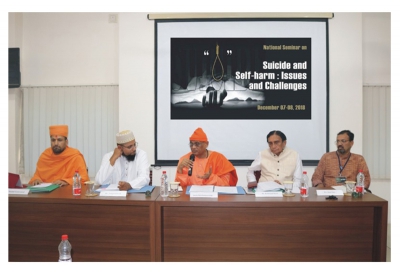
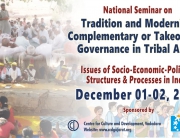
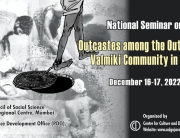
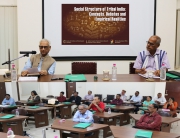
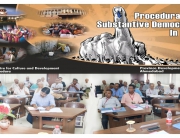
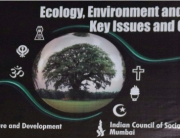
Add Comment